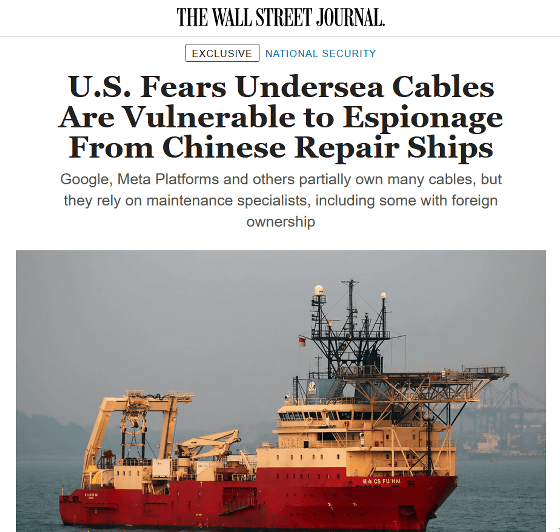US officials warn Google and Meta that undersea cables in the Pacific are at risk of being sabotaged and spied on by Chinese repair ships

The world's internet traffic, including social media and video streaming services, is supported by
Exclusive | US Fears Undersea Cables Are Vulnerable to Espionage From Chinese Repair Ships - WSJ
https://www.wsj.com/politics/national-security/china-internet-cables-repair-ships-93fd6320

Possible Espionage Threat? US Officials Warn Of Chinese Interference With Undersea Internet Cables In Pacific - Benzinga
https://www.benzinga.com/news/24/05/38909612/possible-espionage-threat-us-officials-warn-of-chinese-interference-with-undersea-internet-cables-in
Beijing has increasingly sought to counter US military power in the western Pacific in recent decades, threatening to disrupt the Pentagon's communications and other technological advantages in the event of a clash over Taiwan or other conflict.
The Wall Street Journal, a US daily economic newspaper, reported that US authorities have conveyed concerns to companies such as Google and Meta that Chinese companies could threaten the security of US-owned undersea cables, citing a person familiar with the US authorities' actions. In some cases, the person said, the discussions also included discussions about SBSubmarine Systems (SBSS) , a state-owned undersea cable repair company based in Shanghai, China.
Dozens of undersea cables are spread across the Pacific Ocean, connecting North and South America, Asia, and other islands. However, there are about 200 cases of undersea cables being cut each year due to natural disasters such as earthquakes or ship negligence, and each time this happens, undersea cable repair ships are sent to carry out the work of restoring the cables.
In fact, the following article will give you a good idea of what KDDI Cable Ship's repair ship, Ocean Link, which was engaged in repairing the undersea cables that were cut in the Great East Japan Earthquake, was involved in.
The untold story of a Japanese submarine cable repair ship that was engaged in repairing submarine cables cut by the Great East Japan Earthquake immediately after the disaster - GIGAZINE

During the repair work, a submarine cable repair ship would reel the cable up to the surface, reconnect the broken optical fibers, and then return it to the bottom. U.S. officials have noted that the cables are vulnerable to tampering once they are brought to the surface for repairs, and that it may be possible to install devices to remotely disable the cables during repairs, or to research signal repeater technology.
Of particular concern to US authorities is SBSS, a Sino-British joint venture established in 1995. For many years China Telecom , the state-owned telecommunications company, has held 51% of the shares, and is in the process of acquiring the remaining shares from a British company. This raises concerns that SBSS may be subject to the will of the Chinese Communist Party.
Indeed, The Wall Street Journal has noted that SBSS's submarine cable repair ships frequently turn off their Automatic Identification Systems , which track the ships' locations. According to radio and satellite data from MarineTraffic, a commercial data provider, the transponders on SBSS's submarine cable repair ships have repeatedly stopped working over the past five years.
For example, the submarine cable repair ship 'Bold Maverick,' which left Singapore in 2019, had its transponder switched on and off repeatedly while traveling in a small area less than one mile in diameter for several weeks. Also, the submarine cable repair ship 'Fu Hai' had its transponder turned off for about a month near Hong Kong in early June 2020, and when the signal was detected again, it was sailing off the east coast of Taiwan toward Japan.
Of course, these cases could simply be the result of a transponder malfunction, but a senior U.S. government official said, 'If this were to happen repeatedly, it would raise suspicion, especially if the system were operating near strategically important cables, such as those carrying military communications.'

'The security of undersea cables depends on the ability of trustworthy organizations to build, maintain, and repair them in a transparent and fair manner,' the National Security Council said in a statement, explaining that satellite tracking of undersea cable repair ships is one way to support security.
Google and Meta declined to comment on the U.S. authorities' concerns about SBSS, and SBSS did not respond to requests for comment.
Related Posts:
in Web Service, Security, Posted by log1h_ik






